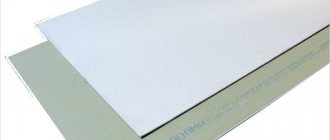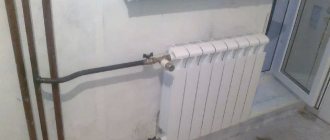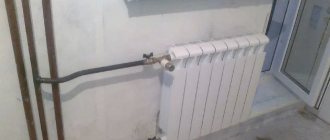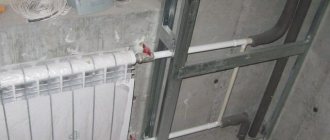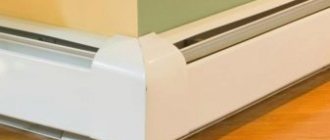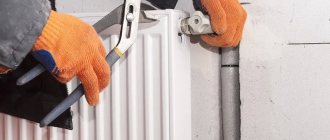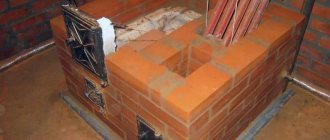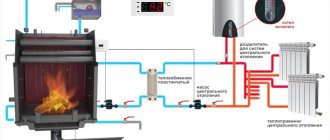An exquisite interior design style rarely welcomes the presence of open communications. When deciding how to hide heating pipes, special care should be taken so as not to cut off the heat supply and cause a fire.
Standard heating system for a private house Source vzsar.ru
Which way is better
The choice of method is determined by the material of the heating system pipes.
If it is a copper alloy, stainless steel, i.e. durable materials that serve regularly throughout the entire life of the building, they can be walled into the wall under a layer of plaster. A good option for masking pipes made of any materials is to install screens. They are simply irreplaceable in rooms where metal risers extend a long distance from the plane of the walls.
The advantage of this method of decorating heating pipes will also be a wide color palette and a variety of screen shapes, from which you can choose a copy that is in harmony with the style of any interior.
It is easy to install and does not interfere with heat transfer, which is very important both for private houses and apartments with centralized heating. https://www.youtube.com/embed/1ixU3Fp6-74
Application of natural wood
Structures made from natural material look great in any interior, but it must be taken into account that wood is a poor conductor of thermal energy. To improve heating, it is recommended to use open top units or large mesh grilles.
It is also important to take into account that high temperatures have a negative impact on wood materials. Under their influence, the wooden box can gradually dry out and become deformed, and the paint can swell.
To avoid this, you must ensure that the device is not adjacent to the elements of the heating system: wooden slats should be 3-4 cm away from them.
Factory ready devices
Such devices are purchased in specialized stores, where a large assortment of products of different colors, sizes and designs is presented. The shape of such structures can be angular, rounded or rectangular.
The first option is especially convenient in the corners of the room for masking risers, and also if the heating system is located close to the ceiling or floor. Other modifications are perfect for pipes that are laid around the perimeter of walls and a free-standing riser.
There are various options for such products. The most common are plastic boxes, which are easily installed around pipes on a metal frame
When choosing such options, it is advisable to pay special attention to the quality of the material, since low-grade polymers under the influence of heat can turn yellow, swell and lose their appearance
Boxes made of regular or perforated metal look very impressive. If a practical goal is being pursued, it is better to give preference to the second option, since thanks to the holes, metal elements provide better heat transfer.
Another option is budget designs made from MDF, which have an attractive appearance and good performance. The disadvantages include a small model range, which is dominated by “blind” devices without holes, which reduces heat transfer.
A smart alternative
Finally, let us ask one question that has been tormenting the author for a long time. Don’t you think that instead of trying to give some kind of beauty to ugly pipes and radiators, you can make them beautiful?
Pipes made of snow-white reinforced polypropylene, laid strictly level and plumb and secured with standard clips, will fit perfectly into the design of any room. Aluminum or bimetallic radiators also look very impressive. They do not need to be decorated: they themselves will become an element of the design of the room.
In addition, you will forget for a long time about any problems with heat and leaking risers. The estimated service life of pipes and modern radiators is estimated at a MINIMUM of 50 years.
That, in fact, is the entire modest point of view of the author of the article on the problem under discussion.
New and neatly installed radiators do not spoil the appearance of the room. Rather they decorate.
Decorative screens for heating pipes
This device is perfect for decorating. It successfully hides bulky radiators and perfectly complements the interior. However, it is inconvenient in practical terms. The screen prevents free access to the battery, impairs heat transfer, and slows down the circulation of warm air masses. Therefore, if you decide to purchase something similar, then it is best to give preference to perforated panels - with them you will not have a problem with thermal conductivity.
A wooden screen with curly elements is perfect for a classic interior.
The wooden panel is secured with magnetic latches
The appearance of the screen should be in harmony with the overall interior of the room
Here the pipes themselves are hidden behind a plasterboard structure, and for access to the joints the rack screen is removable
Models of such panels usually have magnetic latches, hooks, or a hidden lock, with the help of which the product is fixed in place. But it is necessary that the screen can be dismantled without problems.
It is recommended not to neglect this advice, because your batteries will still need inspection and maintenance by a professional (not to mention the possible occurrence of force majeure, such as a sudden rupture of a pipeline), but an impractical decorative canopy can prevent this.
A lattice panel made of thin wooden slats that covers the heating pipes along with the radiator
What are battery screens made of?
As a rule, these are: wood, metal, plastic. There are also perforated, non-perforated, designed to cover one radiator, or bulky, located along the entire wall.
A metal mesh box slightly reduces heat transfer
If heat transfer is not important, the pipes can be laid in a plastic baseboard box
You can make a wooden box yourself
To disguise a boring section of the wall, a stained glass decorative screen is suitable. Due to the many gaps, it will serve as an original design solution and become a feature of your interior.
Construction made of plastic panels
In places where there are a large number of people (for example, in public buildings), as well as in corridors and bathrooms, structures made of durable plastic panels where heating systems are hidden look appropriate.
It is advisable to install such devices in parallel with the cladding of the room, since in this case it is possible to predict the rational consumption of finishing material. Installation of boxes is carried out in stages.
Step 1: securing the frame
First of all, a sheathing made of wooden beams with a cross-section of approximately 40x40 millimeters is attached to the ceiling and walls. These elements are fastened to the walls and ceiling using dowels equipped with a polymer sleeve. After attaching the beams, they are aligned in the horizontal and vertical directions.
In places (on the floor and walls) where heating communications are located, additional support beams are installed, to which frame racks located lengthwise and crosswise will be attached.
Step 2: paneling the frame
Having installed the frame, you can proceed to covering with panels, which is done as follows. Panels cut to the height of the box are installed on the side plane so that they are in a vertical position. You can fasten polymer parts using small nails, special adhesive mixtures, or a construction stapler.
The last stage is the installation of special elements at the corners designed to hide the cut edges, thanks to which plastic boxes for heating pipes acquire a neat appearance.
Infrared floor
This is the simplest and most affordable way to heat bathroom floors. The system consists of infrared film. This system is laid on a concrete screed and attached to it with glue. Ceramic tiles are immediately glued on top. In this case, it will not be the air that will heat up, but the coating, in this case ceramic tiles. The tile will be heated partly by electrical elements and partly by infrared radiation. The surface temperature will be about 26 degrees. When laying, the room itself heats up little. Only the floor remains warm. You can install a heated floor in your bathroom within one day. You don’t have to invite specialists, but after reading the instructions, spread the film with your own hands. If we compare energy consumption, the infrared system is more economical than the electric one. The savings occur due to the fact that there is no concrete screed above this system. These systems are also equipped with thermostats.
Features of decorating pipes in a private house and apartment
There are more options for hiding heating pipes in a private home. Internal communications of private buildings are in no way connected with neighboring ones and, accordingly, if necessary, can be laid and re-routed as they please. If changes to the configuration of the heating system are planned in an apartment building, then the interests of all residents must be taken into account and agreed upon with the operating organization.
Pipes can only be completely hidden during construction or major repairs. For this purpose, hidden gaskets are used in the walls or floor. Pipelines with thermal insulation are placed in grooves and covered with mortar or hidden under moldings. In individual heating systems, floor heating can be arranged. In private houses, it is convenient to hide communications between the logs of wooden flooring. All that remains is to cover the intersections of the pipes with the floor with decorative overlays, as shown in the photo.
The biggest inconvenience for apartment residents is the main transit pipelines, which, due to their large size, are difficult to hide. In addition, if you overdo it with the shelter, you can lose some of the heat entering the room. To disguise them, only external decoration techniques are suitable.
When decorating heating pipes in your home, you don’t have to worry about changes in their heat output. In individual systems, room heating will remain the same, only the ratio of the amount of heat supplied from pipes and radiators will change. But in apartments with centralized heating, you have to save every kilocalorie of thermal energy and leave the pipelines as open as possible.
One way or another, any actions in relation to the elements of the heating system affect its functioning. Before taking drastic measures to move pipelines out of sight, you should study the complete layout of the existing wiring and analyze the possible consequences.
Important! Hidden laying can only be used if new high-quality pipes without threaded connections are used. All dismountable areas and fittings must remain accessible for maintenance
This is especially important in apartments, where the occurrence of an emergency situation is fraught with flooding of neighbors.
In some cases, the best option is to decorate openly laid pipelines and radiators. This allows you to make them invisible at minimal cost, without compromising the integrity of the walls and floor and without changing the configuration of the heating circuit. At the same time, all design parameters of the heating system and free access for ease of operation are preserved. When choosing how best to decorate a heating pipe in a room, you should be guided by both aesthetics and functionality considerations.
How does a radiant heating system differ from a tee system?
Panel radiant heating can operate with maximum efficiency and creates high living comfort. The radiant heating system allows you to connect devices in parallel to the distribution manifold. Two pipes are connected to a special radiator from the collector, the first is the supply, and the second is the return. A heat collector is a fairly large piece of equipment that owners prefer to place in a designated cabinet.
The well-known tee system uses small pipes, but such a connection will require many more fittings. With such a connection, installation becomes more complicated, the probability of breakdown increases several times, for example, from pressure drops and errors during assembly.
Tee heating system
If the wiring is manifold, then the pipe flow increases, all connections are accessible, and thanks to such wiring, repairs can be completed much faster.
A “beam” separate from the system can be easily turned off without turning off the rest of the rooms. Radiant heating can be based on either forced or natural circulation.
Perhaps one of the most important advantages of radiant heating is the ability to neatly hide all the pipes. If you do tee wiring, then it will be impossible to make a hidden gasket, and if you have to do repairs in the future, then you will have to break the floor and walls.
With radial distribution, heating pipes are hidden in the floor after installation
How to decorate a heating pipe
Text of the apartment and cottage "How to decorate a heating pipe":
Before starting European-quality repairs, you should decide how the pipes and heating radiators will be closed. When closing heating pipes, make technological removable hatches in those places where the hot water supply control valves are located. Also, do not forget to leave wide enough openings at the radiators for the influx of cold air and the outflow of heated air. You can quite simply cover heating pipes with laminated chipboard.
You will need
- — wooden beam with a section of 30 by 30 mm;
- - jigsaw;
- - screwdriver and screws;
- — a hammer drill with a Pobedit drill bit with a diameter of 6 mm;
- - yardstick;
- — dowels “quick installation” 6×60;
- — laminated chipboard 16 mm thick;
- - drill;
- — wood drills with a diameter of 4 mm and 6 mm;
- — decorative plastic corners 25×25 mm;
- — copper nails 2×20 mm;
- - hammer.
Instructions
1 Measure the distance from the floor to the top edge of the heating radiator, as well as the distance from the outer edge of the heating radiator to the wall on the side of the heating pipes. Find out the maximum depth to which the radiator and heating pipes extend from the wall. Using this size, assemble a rectangular L-shaped frame from a wooden beam. The top and inner edges of the frame should not reach the plane of the window by 60 mm in the plane of the window sill and 16 mm in the plane of the side slope. Assemble the corners of the frame end-to-end, and if necessary, reinforce them with inserts from the same timber. Drill holes for all screws with a drill with a diameter of 4 mm.
2 In the beam from the wall side, drill holes with a drill with a diameter of 6 mm, retreating 50 mm from the edge of the frame. Drill holes in the middle of the frame at a distance of 400 mm from each other. Place the frame against the wall. Through the 6 mm holes in the frame, mark the location of the holes in the wall for the “quick installation” dowels. Set aside the frame. Using a hammer drill with a drill with a diameter of 6 mm, according to the markings on the wall, punch holes for dowels “quick installation.
3 Place the frame and secure it to the wall with “quick installation” dowels. Determine the location of the service hatches opposite the valves for regulating the hot water supply and air discharge. Assemble from timber and install frames under removable hatches in these places.
4 Set aside 50 mm in height from the top and bottom of the frame opposite the radiator and screw two horizontal beams in these places. These gaps will be used for the influx of cold air (from below) and the outflow of hot air (from above).
5 Use a jigsaw to cut the laminated chipboard into pieces of the required size. Screw the chipboard with screws at a distance of 10 mm from its edge. Nail decorative plastic corners onto the joining corners with copper nails. Use the same corners to trim the edges of the openings for service hatches.
6 Cut out chipboard for service hatches. Make the size of the chipboard smaller than the size of the technological hatches by 5 mm (measure the size from the installed decorative corners). Cover the resulting pieces with decorative plastic corners. Press them into place. If necessary, hang with decorative or hidden small loops.
Sent by: Vasilyeva Svetlana. 2017-09-15 19:49:53 Share
Draping with fabric
It is considered quite elegant to play up PVC and old metal vertical communications with fabric. This is an advantageous solution for living spaces or areas where cooking is carried out. Typically, translucent tulle is used to cover communications. The same canvases should be used to cover windows. You can completely copy the curtains on the windows and use both light and thick fabrics for draping the wiring. In order for the chosen method to look harmonious in the room, you should extend the cornice to the corner where the vertical communications are located and mount it next to them (on the adjacent wall). Thus, the floor-length canvases will cover not 1, but 2 walls at once. Thick canvases can be hung on one side of the window opening and near communications. Or you can use them near the pipe and on both sides of the window. The rest of the space is covered with translucent canvases.
No. 9. Several original ideas
If standard solutions for some reason do not suit you, you can use more original methods:
- stretch fabric to match the walls over the picture frame and use it as a regular screen. The option is naturally suitable for radiators located in a niche;
- Blinds are a very unusual way to hide a radiator, but in some cases it has a place. Installation work is minimal;
- creating a false fireplace above the heating radiator. The frame of the fireplace can be made of plasterboard or plywood, and the hole can be covered with a metal grate. With proper finishing, the structure will closely resemble a real fireplace, and in winter real heat will come from there.
Finish price
Many people who have decided to decorate pipes in their apartments have a question about which method is the most economical. Answering this question, we can immediately talk about painting. If, for example, you choose alkyd enamel as a painting material, then a can will cost you no more than 200 rubles.
Drywall is also an available material for decoration. The cost of sheets of this material starts at 200 rubles. But they alone will not be enough to decorate heating pipes. You will also need profiles, the average price tag for which starts from 50 rubles. You will also need skirting boards, the cost of which starts from 20 rubles.
In order for the plasterboard structure, behind which the pipes are hidden, to look aesthetically pleasing, putty is necessary. Prices for such compositions start from 100 rubles. If you decide to build a false wall, then in this case you will have to spend much more on material. You can't get by with drywall. You will also need to purchase wall panels, prices for which start at 150 rubles. for 1 sq. m. You will also need screens for radiators, which cost 300 rubles in stores.
You can also decorate heating pipes in an apartment by using jute rope. This material is quite inexpensive. The maximum price for it is 120 rubles. for 1 linear meter. You can also use hemp rope, prices for which vary from 10 to 880 rubles. The most expensive method is stained glass. If you choose this option for decorating pipes in your apartment, you will have to pay several thousand rubles for this pleasure.
What do you need to do before starting work?
You need to start decorating the heating risers in your apartment only after preliminary preparation has been completed. If the communications in your apartment are old, then before installation they must be replaced with new ones. Sheathing involves an insulation device. It is necessary to put a layer of polyethylene on the pipe or a special sleeve instead. Regardless of the chosen decoration method, the pipeline must be washed before decoration. If you decide to paint heating pipes, then serious preparation will be required.
- It is necessary to remove traces of previous finishing from the surface of the pipe.
- The surface must be cleaned with a wire brush.
- It is also necessary to perform priming.
By deciding to decorate the pipes in your home in an original way and using your imagination, you can get an original interior element and achieve an incredible effect in the room.
Pipe boxes
Very often there are situations when the heating system is already installed. The installation of boxes will help in deciding where to hide the pipes.
Stages of constructing a box:
- Preparation of frame elements. They can be made of metal profiles or wooden beams.
- Applying markings on structures depending on the location of pipes.
- Installation of the frame and fastening it to the wall.
- Frame cladding.
- Decorative finishing of the box.
If the distance between the outer posts is more than 0.5 meters, additional posts are inserted between them. When the height of the racks is more than 1.5 meters, it is necessary to install horizontal jumpers.
Before cladding the frame, you should put a special cover on the heating pipe, which will reduce heat losses from the system.
DIY materials
Resources for homemade protective installations for smoke ducts are selected depending on the characteristics of the planned work. Most often, galvanized steel sheets or corrugated stainless steel are used. If the process of arranging a gas duct indoors or on the attic floor is to be done, fire-resistant plasterboard is used. For brick chimneys, wooden protection is sometimes made in combination with basalt insulation and steel cladding. At the same time, do-it-yourself galvanized and corrugated chimney casing models are positioned as durable and effective options.
Disguise methods
There are many ways to close heating pipes in a private house or apartment. The most radical is to hide them altogether, the least is to decorate them with decorations.
At the same time, in individual heating systems, the volume of heat will be distributed between radiators and pipes, and in apartments with central heating, pipe insulation often results in heat loss. But there are ways to avoid this problem.
Place inside walls or floors
Pipes can be hidden inside walls or floors. It is very convenient and aesthetically pleasing. To lay the main line, a groove is made, the pipes are wrapped in heat-insulating material and laid in a recess in the wall, then it is sealed or covered with plasterboard.
All connections and valves should under no circumstances be walled up in the wall - in the event of a breakthrough, it will have to be broken down. Old pipes cannot be insulated in this way.
Hide in a box
Another way is to place the pipeline in a plasterboard box on a metal profile. The box can be painted, plastered, covered with wallpaper - this gives a huge selection of options for decorating heating pipes. You can choose perforated metal - it looks stylish and has good heat dissipation. It is also possible to hide the gas line under a ready-made plastic box.
If plastic is chosen for masking, it must be of proper quality: some types of this material turn yellow and swell when heated, so it is necessary to clarify its technical characteristics.
It is important to remember the rules: the pipe must be at least 5 cm from the walls of the box, and it is also necessary to provide access to taps and fittings
Painting and decorating
The pipeline is painted with paint, matching it to the color of the walls or, conversely, in contrast. Decorate the risers with a tourniquet and rope. Sometimes a bamboo outline is made for them. Later, appliqués made of paper, leather or fabric can be placed on top - this is a decoupage technique that is widespread in modern design.
It is necessary to paint heating elements only when they are in a cold state - when the heating is turned off. Rapid heating may cause the paint to crack.
Disguise with furniture
Disguising it with furniture is the easiest way: push the riser with a cabinet - and no money or hassle. This is convenient to do in the kitchen and bathroom, where furniture is most often placed around the perimeter of the room close to the walls. Special holes are made in the back and side walls of kitchen cabinets.
At the same time, in living rooms it is problematic to disguise pipes with furniture: risers and radiators are located, as a rule, on the wall where the window is, and you can’t put a cabinet there.
Close with screen
Decorative screens are a great way to hide not only risers, but also radiators. The screen can be made of glass or transparent plastic, or even designed in the form of a stained glass window - beautiful, intriguing, stylish. If there is lighting, it will add mood to the interior and can serve as a night light.
To avoid problems with heating, there is an option to make decorative grilles through which heat will still flow. In this case, all screens must be removable.
Prices for screens for radiators
screens for heating radiators
Construction of a false wall
A false wall also allows you to hide all communications from view. Behind the artificial wall, not only heating risers can pass, but also a gas main, electrical wires, and a coaxial cable for a TV.
You just have to remember that a false wall reduces the space of the room. And some elements cannot be left without access. For example, gas workers are very unhappy when they try to hide a gas pipe.
Hide behind a suspended ceiling
This method is not so popular. However, in a private house it can be used if the heating distribution of the first floor is made under the ceiling, and the second floor - under the floor. In this case, a suspended ceiling is installed. Although, for all its practicality and elegance, it also reduces the space of the room, this time the height.
Prices for different types of suspended ceilings
suspended ceiling
This is interesting: Installing a check valve on a sewer - vacuum + water seal
Preparation for installation
The primary task is to draw up an installation drawing of future highways. In fact, the pipeline plan must be carried out taking into account all connections, taps, technological cabinets, shut-off valves. Detailed planning helps to avoid redundant connections and waste of material, since it is determined in advance which parts and in what quantities are needed.
Walls for hidden installation of pipes will have to be grooved, that is, a channel will have to be cut in the concrete for laying a pipe line. It is advisable to pre-mark the working area in order to make an even and high-quality channel.
It is advisable to take into account that it is not recommended to groove walls in panel houses, since the thickness of the panels is usually small. The most suitable walls are made of thick brick or concrete. They can be tapped without fear.
Next, you need to mark the pipes and fittings to know the welding direction and installation order. If necessary, it is better to trim the products in advance.
To perform installation work, you need tools designed for polypropylene:
- cutting scissors;
- a shaver for removing reinforcement and a chamfer for leveling the cut surface;
- welding machine with temperatures up to 260 °C;
- wall chaser or grinder for cutting out a cavity in the wall;
- chisel and hammer or punch to remove material between the grooves.
Installation
When the tools are ready, there is a detailed plan for installing pipe lines and markings, you can start working:
- Using a grinder or wall chaser, cut parallel to each other slots on the concrete surface of the wall; the distance between the slots should be slightly greater than the thickness of the polypropylene pipe in the thermal insulation. It is recommended to use a stone disc or a toothed disc coated with diamond.
- Use a hammer drill or chisel to remove concrete between the slots.
- To place technological cabinets, you will have to make a cavity in the wall and install a cabinet with slots for communications in it. This design will facilitate access to shut-off valves or sensors.
- The pipes are welded in advance, after which they are laid in the wall and fixed in the channel with clamps or supports. It is advisable to do most of the welding outside the channel because it is easier than welding in a confined space. Before sealing the grooves, it is recommended to check the system for leaks by running water into it. If no leaks are observed, then you can proceed to the final finishing.
- Before laying the pipes, it is advisable to wrap them in a layer of energyflex, or fill them with polyurethane foam after installation. This will provide space for the pipe to expand.
Of course, you can lay pipes on top of the walls, and make finishing on top of the main line, but then the free space in the room is reduced, and the cavity formed between the finishing and the wall will have to be filled with insulation. This approach is ineffective, since the finishing material must adhere tightly to the surface.
If you need to hide a ready-made pipeline structure, it is better not to make a blank monolithic wall, but to build a special plasterboard box to ensure free access to the pipes if necessary.
After a test check of the functionality of the pipeline, you can begin finishing the wall; it is better to use drywall for this.
Masking heating pipes in the wall
Pipes, risers and radiators can be disguised in several ways. A fairly popular option is to hide communications in a wall or in a field.
At the same time, it is important to replace old pipes with new ones in the apartment before such work. It is better to choose plastic communications. Otherwise, leaks will occur, which are quite expensive to fix.
Otherwise, leaks will occur, which are quite expensive to fix.
The sequence of installing pipes in the wall:
- First, a communication layout is created. This takes into account the cross-section of the pipes, thermal insulation and the thickness of the wall layer that needs to be sealed.
- Next you need to make a hole in the wall. This is a special recess in which communications will be placed. Provides space for bends and tees.
- Then insulation is put on the pipe and mounted in the provided niche. Communications should be well secured, ensuring reliable fixation.
- The pipes are secured using brackets. To do this, holes are made in the wall with dowels. They are the ones who will fix the device.
- Next you should check the functionality of the pipes. Only after this the niche is sealed.
The second method involves sealing pipes in the floor. First, think through the laying scheme. A groove is made in the floor. The top of the pipe should be slightly below floor level. Next comes pipe insulation, inspection and installation. Communications are closed with concrete mortar. For normal water circulation, a pump is installed.
But if you hide the pipes this way, you should be prepared that in case of a leak, you will have to completely dismantle the floor or wall
That is why it is important to reduce all risks to a minimum. One-piece pipes or those with a minimum number of joints should be selected. This option can be called a warm floor
This option can be called a warm floor.
With ropes
The original decor of vertical and horizontal communications can be done with ropes. It is not recommended to use the cheapest jute ropes (with an uneven surface) for work, since they quickly become covered with dust and it is difficult to remove. But neat, smooth analogues made of jute (regular or dyed) are suitable for use in living rooms and toilets. Vertical layout using this material can be stylized as wood or palm tree. For such decoration, it is recommended to fix artificial greenery, branches with plastic lemons or oranges in the upper part of the braided communications.
In a small Khrushchev-era building, using thin ropes, you can create original marine decorations. White cotton ropes are suitable for the job. In this case, the horizontal wiring can not only be braided, but also decorated with flowing ropes. Additionally, small shells can be glued to the braid.
Decoration methods
If the pipes in your house or apartment are already old, it is better not to hide them. Firstly, during the installation of various sheathing, the pipeline can be easily damaged, since old materials usually become somewhat brittle. Secondly, such pipes are more susceptible to leaks, so it is advisable to keep them in sight in order to detect the problem in a timely manner.
But this does not mean that nothing can be done with them. With a little imagination, you can easily turn these elements into a wonderful interior detail. There are several simple ways to do this:
- painting. The most obvious method is to give the pipe the desired beautiful color. At the same time, you can choose a shade that will blend with the surrounding environment, due to which the pipeline will not be noticeable. But you can also make a knight's move and play on contrasts - try turning the pipe into a bright spot that interestingly matches the color of the walls. It is likely that this will become some kind of “feature” of your room. Often such a simple option gives a very advantageous effect. The main thing is to choose the right not only color, but also the quality of the paint. It must be heat-resistant, not harmful to the environment and resistant to mechanical stress. Acrylic or alkyd-based enamel is perfect for this;
- finishing. It all depends only on your imagination. You can wrap the battery with beautiful ropes, threads, and rope. A jute cord will also work, but it is quite possible that the design will be appreciated by cats and will not last long. You can decorate it using fabric or a light garland. Artificial plants will also work, but make sure they are made from heat-resistant, non-melting materials. You can also arrange a bamboo finish, or even make a kind of “reminder” out of the pipe, attaching multi-colored stickers with notes to it - then it will have another practical meaning. And if you have experience making furniture, you can connect circular shelves. Naturally, they will not be mounted on a pipe, but on a vertical support, but the camouflage will be excellent, and again, they will be useful. In general, there are a lot of options. It is quite possible that you will come up with some of your own - then share your ideas with your friends on social networks, showing them this article at the same time.
As you can see, heating pipes are not such a terrible element at all. They can be hidden quite easily, or even turned for good, turning them into a bright and interesting detail of the element. Just do not forget in the process that the main function of the pipe is still heat transfer, so do not get carried away with completely closing the element from all sides. It is advisable to leave some gaps for heat to escape: perforations, grilles, etc. In general, a little imagination and work - and anyone will envy your design. Good luck! https://www.youtube.com/watch?v=Wq2dQZ7kZNU
We recommend reading:
What to do if there is an unpleasant smell from the ventilation in the toilet: solving the problem on your own
Arrangement of ventilation in the toilet of a private house: just about the important
What to do if the boiler is leaking from below or from above: the correct methods for identifying and troubleshooting problems
Kinds
In order to decorate pipes in a room and hide them from those present, you can use several options, these are:
Recessing heating structures directly into the wall, which in itself is very convenient and not so difficult to implement, but in case of any problems the consequences will be very bad
When installing a pipeline, it is important to completely replace it and carefully check all fastening points, soldering points and any joints that may leak. Disguise using furniture, which is most often typical for the kitchen, but can sometimes be found in other rooms. Using a special box where the pipes are placed. You can make such a structure from different materials, these are: plastic lining, brick, plasterboard, wood.
The box for heating pipes can have a varied appearance, which depends on the room in which it is installed.
- A box-cabinet that forms a closed space where you can not only hide pipes, but also place little things you need in everyday life. It is very convenient to use it in the toilet, where space is significantly limited.
- A plinth box is needed to hide pipes with a small diameter; it is very convenient to install sockets near them, especially for the bathroom, where the humidity level is high and you need to choose the right place to turn on electrical appliances.
- A shelf box with a horizontal arrangement. This is convenient for proper installation of heating structures in the room. You can effectively, but at the same time effectively hide all communications, making the area useful.
- A screen box that helps cover large structures. Screens can be very diverse in design and size, but they will have one thing in common: a mesh structure, which allows you to minimize heat loss without depriving the room of its aesthetics.
- Decorative vertical structures are installed in places of common building communications, most often these are risers.
When planning the construction of any of the above options, you need to know that you can build two types of structures that will have radically opposite characteristics:
- Collapsible structures, their installation allows you to easily monitor the condition of the pipeline in any part of the room and control problem areas, if any.
- Stationary structures that are installed for the longest possible service life and are not planned to be disassembled for a long time. Most often, such boxes are made for gas pipes; they would not be the best option for heating.
Any type of structure can be purchased or made independently, which requires an understanding of what exactly will be built and the use of the correct structural elements. If you need to hide the battery, then you cannot do without a screen, and it must be perforated, otherwise it will not be able to cope with the task and the box itself will overheat, while the room will remain cold. The gratings can be either plastic or wooden, but if desired, you can even order forged products.
Any pipes that are in a house or apartment have an entry point and exit point from the room, which obliges them to decorate these areas as well. The best way to deal with this is overlays or plugs. Externally, they can have a varied appearance and even be made of different materials, but they have one task, to hide the pipe and make the interior of the room stylish and beautiful. Most often, it is the rings that are found, but you can also find square and oval options; in addition, they can be designed for one or two pipes.
Modern technologies also require new approaches to the use of materials; for example, when installing suspended ceilings, pipes need to be bypassed, which, in turn, requires making holes in the canvas that need to be closed. Decorative rings are now used for such purposes.
Their design is extremely simple, but still effective, these are two identical halves that have a special lock at the junction that snaps into place and is securely held in place
It is important to choose the right material and color of such plugs so that they fulfill their role
In the event that you cannot hide the entire pipe, but you need to decorate it beautifully, cups are great for this. They can be made in different sizes, shapes and materials. Chrome is most often used, but plastic can also be used, which has a split design.
If the design has valves or other moving elements that need to be used from time to time, then you can hide them under a cap that matches the decor of the room, so as to blend in with it and not be noticeable, but if necessary, make it possible to use everything you need.
Conclusions and useful video on the topic
The videos below demonstrate the manufacturing process of the most commonly used boxes for masking heating systems: plastic and plasterboard.
Video #1. Instructions for masking pipes behind plastic panels:
Video #2. Compact box made of waterproof plasterboard:
To hide heating pipes, it is important to choose the most effective method of disguise. It will not only remove utility lines from view, but also decorate the apartment.
By investing taste, imagination, and creativity, you can choose a unique finish for decorating pipes, even without special skills in carrying out repair and construction work.
Please write in the block below. Tell us about how you hid the heating system pipes in your own city apartment or country house. It is possible that your valuable recommendations will be useful to site visitors.
